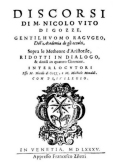

By Nenad Buzjak
Speleo club Samobor
In 1999. Croatian cavers celebrate two important anniversaries connected with Nikola Vitov Gucetic, a statesman, philosopher, writer and author of the first speleological scientific dissertation in Croatia: the 450th anniversary of his birth and 415th anniversary of publishing his book Sopra le Metheore d' Aristotile, in which the above mentioned dissertation was published.
 Nikola
Vitov Gucetic was born in 1549. in a rich family in Dubrovnik. He was educated
in Dubrovnik and periodically in Italy. After that, he rarely traveled out of
his native town. He was occupied by trade, finances and many important official
duties in Dubrovnik, where he was elected seven times for its duke. He was not
only a statesman who devoted his life to the prosperity of Dubrovnik, but also
a famous philosopher and writer.
Nikola
Vitov Gucetic was born in 1549. in a rich family in Dubrovnik. He was educated
in Dubrovnik and periodically in Italy. After that, he rarely traveled out of
his native town. He was occupied by trade, finances and many important official
duties in Dubrovnik, where he was elected seven times for its duke. He was not
only a statesman who devoted his life to the prosperity of Dubrovnik, but also
a famous philosopher and writer.
Gucetic was the central person of a cultural life in Dubrovnik and owned probably the biggest private library in town. He became famous owing to his philosophical works and political, sociological and pedagogical dissertations. According to political and cultural situation of his time, and probably in attempt to be accsesible to as many readers as possible, he wrote in Italian. The pope Clement VIII awarded him the honorary doctorate of philosophy and master's degree of theology, which proves that his work was respected out of Dubrovnik as well.
 In the year of 1584. in Venice was published first, and then in 1585. the second
edition of his book Sopra le Metheore d' Aristotile (About Aristotle's meteors).
This work is a comment on Aristotle's explanations of natural phenomenon according
to the principles of natural philosophy. In a part of the book in which he explains
the origin of the wind, Gucetic mentions two caves: Sipun cave near Cavtat in
Dubrovnik area and one unnamed cave in Popovo polje in Bosnia and Herzegovina
(probably Vjetrenica cave) famous for strong wind at its entrance. The origin
of winds in general and winds in caves Gucetic explained by evaporation of the
elements of the Earth caused by the Sun. This evaporation is warm, dry and dense
and therefore it cannot penetrate towards the Earth surface through the ground,
but only through larger openings such as cave entrances. Such circulation produces
wind. He also noted that this wind is not observable deeper in the cave, but
only at the entrance. He explained that by acceleration of air current in narrower
parts of cave passages, similar to the acceleration of sea currents in narrow
sea passages. In the case of a windless Sipun cave Gucetic stated that this
phenomenon is not universal for all caves. He explained the absence of wind
on its entrance by its higher humidity and presence of a lake in one passage.
According to his opinion, the bigger amount of water is favorable for the growth
of speleothems which are abundantly present in this cave.
In the year of 1584. in Venice was published first, and then in 1585. the second
edition of his book Sopra le Metheore d' Aristotile (About Aristotle's meteors).
This work is a comment on Aristotle's explanations of natural phenomenon according
to the principles of natural philosophy. In a part of the book in which he explains
the origin of the wind, Gucetic mentions two caves: Sipun cave near Cavtat in
Dubrovnik area and one unnamed cave in Popovo polje in Bosnia and Herzegovina
(probably Vjetrenica cave) famous for strong wind at its entrance. The origin
of winds in general and winds in caves Gucetic explained by evaporation of the
elements of the Earth caused by the Sun. This evaporation is warm, dry and dense
and therefore it cannot penetrate towards the Earth surface through the ground,
but only through larger openings such as cave entrances. Such circulation produces
wind. He also noted that this wind is not observable deeper in the cave, but
only at the entrance. He explained that by acceleration of air current in narrower
parts of cave passages, similar to the acceleration of sea currents in narrow
sea passages. In the case of a windless Sipun cave Gucetic stated that this
phenomenon is not universal for all caves. He explained the absence of wind
on its entrance by its higher humidity and presence of a lake in one passage.
According to his opinion, the bigger amount of water is favorable for the growth
of speleothems which are abundantly present in this cave.
Dadic, Z. 1984: Osvrt Nikole Gucetica u 16. stoljeću na dvije spilje u okolici
Dubrovnika (The review of Nikola Gucetic in 16th century on two caves in environs
of Dubrovnik). 9. jug. speleološki kongres (Proceedings), 741-746, Zagreb
Prosperov Novak, S. 1997: Povijest hrvatske knjizevnosti, knjiga 2: Od humanistickih
pocetaka do Kašiceve ilirske gramatike, 469-479, Izdanja Antibarbarus, Zagreb